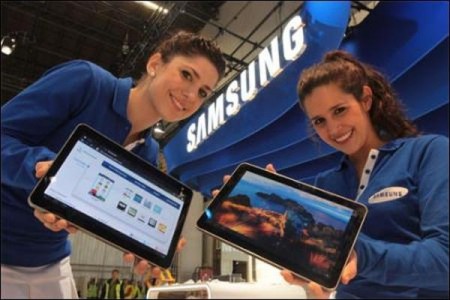Galaxy Tab Has Smaller Screen, Similar Features to Apple’s Device; Likely Cost Is $200-$300.
Samsung Electronics on Thursday unveiled the Galaxy Tab, its take on Apple’s iPad, as more technology companies trickle into the nascent tablet market. Tablets represent a potential new source of revenue for Samsung, which is making up for lost ground in the intensely competitive smartphone business.
Rather than sell it directly to consumers, Samsung will rely on its carrier partners to sell the Galaxy Tab, which runs on Google’s Android software, comes with a cellular connection, and features a seven-inch screen. The tablet will debut in Italy, moving to other markets as Samsung locks in more carrier deals.
Vodafone Group, the world’s biggest mobile operator, said it would start selling the Galaxy Tab in most of its European markets and a number of its other markets worldwide in October.
It is expected to launch in the U.S. over the next few months, but the company would only say it was in talks with multiple carriers. The Galaxy Tab is essentially an enlarged version of Samsung’s flagship Galaxy S smartphone, which was originally available through AT&T and Deutsche Telekom’s T-Mobile, and more recently Sprint Nextel Corp.
While a price hasn’t been set, Samsung product executive Hankil Yoon said in an interview that it would likely retail for between $200 and $300, although the final price would vary depending on different carrier subsidies.
Mr. Yoon expects to ship 10 million units and take a third of the global tablet market next year.
But it’s unclear if any tablet beyond the iPad will prove to be a hit. Samsung follows Dell which launched its Streak through AT&T last month. More tablets are expected for the holiday selling season.
While many companies are devoting resources toward building a worthy iPad competitor, history shows that Apple often enjoys a lengthy lead with its products, said Rhoda Alexander, an analyst at iSuppli.
The iPad, which sold 3 million units after 80 days in the market, is expected to control three-quarters of the tablet market this year, with its share only slipping to 62% by 2012, according to iSuppli.
Like the iPad, the Galaxy Tab customizes core applications, such as email and contacts, to take advantage of the larger screen, offers Wi-Fi capabilities, and provides a hub for reading magazines, books and newspapers. It also lacks a removable battery and requires a proprietary dock to connect to a PC.
The Tab sets itself apart on size. The 7-inch screen allows for a slimmer profile than the iPad, which packs a 9.7-inch screen. Also, the Samsung device supports the latest version of Adobe Flash–something the iPad doesn’t do–enabling the Tab to show more video found on the Internet.
It features a camera on each side of the device, as well as a slot for expandable memory. It also has the capability to make phone calls, but carriers will decide whether that capability will be offered. Mr. Yoon said Samsung plans to support the device with two major software updates a year.
The Tab will run on Android 2.2, the latest version, and will have access to the Android Marketplace for a number of applications. But Gartner analyst Carolina Milanesi said she was concerned about how many apps will be designed specifically for the device. The iPad already benefits from a number of third-party apps that utilize its larger screen.
Samsung is exploring the possibility of a tablet with a 10-inch or 6-inch screen, and Mr. Yoon said the company plans to eventually launch a family of Galaxy Tab devices. Samsung has invested $200 million in advertising the Galaxy S phone around the world. The company plans to spend less promoting the Galaxy Tab, because it feels the product appeals to more of a niche audience than the more mainstream smartphone, said Samsung mobile marketing executive Younghee Lee.
Views: 430



